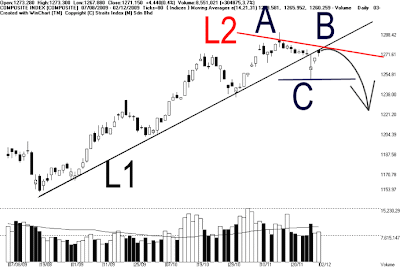Even though the KLCI has broken below the L1 uptrend line, it is still too soon to call for a downtrend. Let's us study the 3 possible scenarios for the KLCI, so that investors can be prepared, and re-act calmly according to their trading plan.
Chart 1: KLCI chart from 10/8/2009 to 2/12/2009
As indicated by A, the KLCI was pulled down by negative performance of the world markets, breaking below the L1 uptrend line. Currently, we are monitoring if the KLCI could resume the L1 uptrend line, or the uptrend is already over? We shall take a look of the 3 simulated charts of the KLCI below.
KLCI to form a Downtrend:
Chart 2: KLCI simulated Lower-High, downtrend.
As shown on chart 2, if the KLCI should failed to break above the 1280 ~ 1288 resistance, and even formed a Lower-higher, as indicated by B, it would be a first signal that the L2 downtrend is formed. If price should later break below the latest 1250 support, as indicated by C, it would confirm the formation of a downtrend, using point A and point B. Provided that the KLCI is staying below the L2 line, the downtrend remains intact. Meanwhile, a typical characteristic of a downtrend is a lower volume below the 40-day VMA level.
KLCI to form a Double Top:
Chart 3: KLCI simulated Double Top.
As indicated by A on chart 3, if the KLCI should test the 1280 ~ 1288 resistance, and resisted again, there is a chance of forming a Double Top. A Double Top is a reversal signal, suggesting investors are breaking-even at the previous resistance line, and the selling pressure is quite strong that the buying interest failed to push the price above the previous resistance. If price should retreat and break the support level at B (1250 level), the KLCI would form a downtrend.
KLCI to resume its uptrend:
Chart 4: KLCI simulated resuming its uptrend.
As shown in chart 4, the arrow B indicates that the KLCI breaks above the L1 line and even breaking above the previous 1288 resistance at A, thus resuming its uptrend. However, the bullish break out of the KLCI has to be confirmed with significant increased of volume, or else, the bullish break out is less affirm. Nevertheless, if the KLCI could break above 1288, the next resistance for the KLCI is seen at 1300 level, and the 14, 21, 31 EMA shall resume its role as a dynamic support.
This week's Case Study: CIMB
Chart 5: CIMB 1023, chart from 7/8/2009 to 2/12/2009.
As shown on chart 5, price of CIMB retreated as the KLCI dipped. However, it is still supported by the 14, 21, 31 EMA, which has been supporting its uptrend for quite some time. This shows that the uptrend is still intact, while not affected by the negative news over the concern of the Dubai incident. Nevertheless, since CIMB is a KLCI component stock, its movement is closely related with the KLCI movement. Therefore, analysis of CIMB must be referred to the analysis of the KLCI.
With the uptrend of CIMB remains intact, investors who are still holding CIMB should follow their trading plan, and use the dynamic trailing stop method. In short, provided that the price of CIMB is still above the 31 EMA, it is still a good idea to hold. Unless investors should feel very uncomfortable, a partial profit taking is also a wise move. However, for those who are prospecting a buy signal, there is no buy signal for CIMB yet for the Bollinger Bands is still contracting. Unless the Bollinger Bands re-expands with the price of CIMB above the Bollinger Middle Band, then only it is a buy signal, with the Bollinger Middle Band as the immediate cut-loss point.
Nevertheless, support for CIMB is seen at RM 12.65 WinChart Automatic Fibonacci Retracement while the next support is at RM 12.10. Resistance for CIMB is at RM 13.48 WinChart Automatic Fibonacci Retracement.
| Rolling 4 Q PE | 16.99 times | Dividend Yield | 1.94% |
| Dividend | Dividend Yield | Net Profit Ratio | |
| 31/12/2008 | 25 sen | 3.85% | 25.22% |
| 31/12/2007 | 25 sen | 2.40% | 31.00% |
| 31/12/2006 | 15 sen | 1.90% | 23.53% |
| 31/12/2005 | 15 sen | 2.73% | 17.51% |
| 31/12/2004 | 15 sen | 3.19% | 18.01% |
Table 1: CIMB yearly Dividend, Dividend yield, and Net Profit Ratio.
Conclusion:
From the above 3 simulated scenarios, investors will have a better idea of what to look forward to, and the different characteristics as well as criteria of each outcome. Therefore, a wise investor who are still holding shares should plan ahead of the outcome, and practice a sound trailing stop method. As for investor who are looking for buy signals, must wait patiently for the signals and never buy too early. Once entered a position, a trailing stop method shall be in place to protect against major reversal.
Copyright © 2009 Straits Index (M) Sdn BhdImportant Disclaimer:These content provided by Straits Index (M) Sdn Bhd is solely for education and information purposes only, and do not suggest any investment advices. All information displayed are believed to be accurate and reliable. Interpretation of the data or analysis is at the reader's own risk. Straits Index (M) Sdn Bhd reserves the rights but obligations to update, admen, or even terminate the materials. 重要声明:以上的内容由海峡指数(马)私人有限公司提供,纯粹是教育性质, 并不是任何的投资忠告。所有资料显示认为是准确和可靠的。对数据或分析的解释和用途是在于用户自己的风险。海峡指数(马)有限公司持有保留及义务更新,甚 至终止材料的权利。




